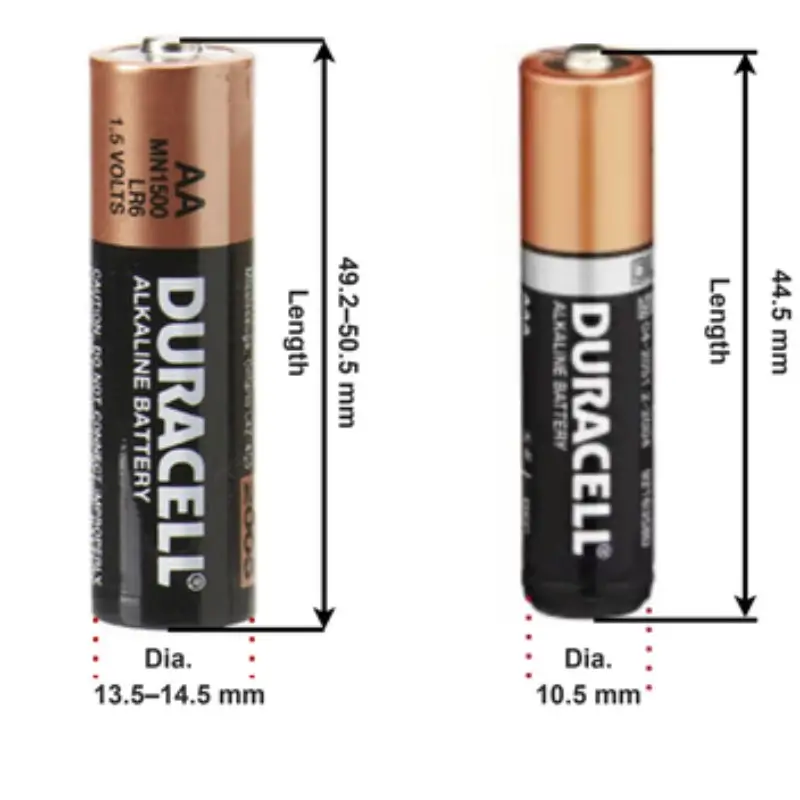Introduction
Batteries power our everyday gadgets, from TV remotes to digital cameras. But when choosing between AA vs AAA batteries, do you know the key differences? The wrong choice could mean shorter battery life, wasted money, or even device damage.
In this guide, we’ll break down 7 crucial differences between AA and AAA batteries, helping you pick the best one for your needs. Let’s dive in!
Not sure if your device supports AA or AAA batteries? For smaller electronics like watches and medical devices, check out this LR41 Battery Equivalents Guide to find the best replacements.
Quick Comparison: 7 Key Differences Between AA vs AAA Batteries
| Feature | AA Battery | AAA Battery |
|---|---|---|
| 1. Size | 50.5mm x 14.5mm | 44.5mm x 10.5mm |
| 2. Capacity (mAh) | 2000–3000 mAh | 1000–1200 mAh |
| 3. Voltage | 1.5V (Alkaline) | 1.5V (Alkaline) |
| 4. Power Usage | Best for high-drain devices (cameras, toys) | Best for low-drain devices (remotes, clocks) |
| 5. Cost | Slightly more expensive | Slightly cheaper |
| 6. Weight | Heavier | Lighter |
| 7. Rechargeable Options? | Available in NiMH & Lithium | Available in NiMH & Lithium |
AA batteries are bigger, store more power, and last longer than AAA batteries, making them ideal for high-power devices.
1. Physical Size: Why AA is Bigger

The first and most noticeable difference between AA and AAA batteries is size.
- AA Batteries: Larger & thicker (50.5mm long, 14.5mm wide)
- AAA Batteries: Smaller & thinner (44.5mm long, 10.5mm wide)
The larger size of AA batteries allows them to store more energy, making them ideal for high-drain devices. On the other hand, AAA batteries are compact, meaning they hold less power but are perfect for smaller gadgets like TV remotes, wireless mice, and clocks.
2. Capacity (mAh – Milliampere-hours): How Long Do They Last?
Capacity is measured in mAh (milliampere-hours) and determines how much energy a battery can hold before it runs out.
- AA Batteries: Higher capacity (2000–3000 mAh)
- AAA Batteries: Lower capacity (1000–1200 mAh)
Since AA batteries store more energy, they last longer in high-drain devices like digital cameras, gaming controllers, and flashlights. AAA batteries hold less energy and are better suited for low-power devices like TV remotes and LED fairy lights.
3. Voltage: Do AA and AAA Batteries Have the Same Power?
Both AA and AAA alkaline batteries provide 1.5V of power, meaning they can be used interchangeably in some devices (if size allows).
However, rechargeable batteries can have slightly different voltages:
- NiMH rechargeable batteries: Usually 1.2V
- Lithium batteries: Can go up to 1.8V
This voltage difference affects performance in high-drain devices. For example, a camera might perform better with lithium AA batteries than standard alkaline ones.
4. Power Usage: Which Battery is Stronger?
Both AA and AAA batteries provide 1.5V, but their power output depends on the device they are used in.
- AA Batteries: Handle high-drain devices better (e.g., cameras, toys, flashlights).
- AAA Batteries: Best for low-power devices (e.g., TV remotes, clocks, wireless keyboards).
Devices that require more energy over a longer period benefit from AA batteries, whereas low-drain electronics work fine with AAA batteries.
5. Cost: Are AA or AAA Batteries Cheaper?
- AAA batteries are slightly cheaper because they are smaller and contain less material.
- AA batteries cost more but last longer in high-drain devices, making them more cost-effective for certain applications.
For budget-conscious buyers:
- Use AAA batteries for low-power devices (e.g., remotes, clocks).
- Use rechargeable AA batteries for high-drain gadgets (e.g., cameras, gaming controllers).
6. Weight: Which Battery is Lighter?
- AA Batteries: Heavier (~23g per battery)
- AAA Batteries: Lighter (~11g per battery)
Weight matters for portable electronics where every gram counts. For example, in TV remotes, wireless mice, and travel gadgets, AAA batteries are preferable because they keep devices lightweight.
7. Rechargeable Options: Which Battery is Better for Reuse?
Both AA and AAA batteries are available in rechargeable versions (NiMH or lithium), but AA rechargeable batteries have a longer lifespan because of their higher capacity.
- AA Rechargeable Batteries: Hold more charge, better for high-drain devices.
- AAA Rechargeable Batteries: Work well for low-power gadgets but need recharging more often.
Best Choice for Sustainability:
- Use AA rechargeable batteries for flashlights, cameras, and gaming controllers.
- Use AAA rechargeable batteries for remotes and small gadgets.
If you’re looking for alternatives to standard AA and AAA batteries, you might also be interested in our LR41 vs LR44 Battery Guide, which compares two popular button cell batteries used in small electronic devices.
Conclusion: Which Battery Should You Choose?
- For high-drain devices (e.g., cameras, toys, game controllers) → AA Batteries
- For low-drain devices (e.g., remotes, clocks, LED lights) → AAA Batteries
Pro Tip: If you use batteries frequently, invest in rechargeable AA and AAA batteries to save money and reduce waste.
For those wondering about other battery comparisons, we’ve also covered SR41 vs LR41 Batteries, helping you understand the key differences between these two small batteries.